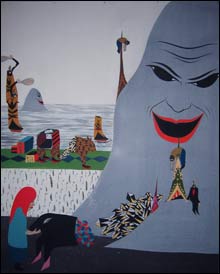
Clare Rojas, Untitled (2005) |
Artist Julia Scher was way ahead of the Homeland Security gang’s obsession with electronic eavesdropping and video voyeurism, having made high-tech installations that allowed museum and gallery goers to watch each other watching each other since the late 1980s. “The monitors of surveillance are the eyes of a social body gone berserk,” she wrote in 1991. In our post-9/11 world, her early, paranoia-inspiring art looks prophetic. Scher is one of more 20 artists whose work is on view in “Balance and Power: Performance and Surveillance in Video Art,” which opens at Brandeis’s Rose Art Museum September 20. The exhibit will feature a dozen video installations. Jenny Marketou’s 2003 project Flying Spy Potatoes utilized digital recordings made with a wireless spy-cam mounted on a helium balloon on a 30-foot tether that the artist walked through high-security spaces in New York. For historical context, there’s early work by video pioneers Andy Warhol, Vito Acconci, and Bruce Naumann, who explored the power of seeing, and being seen through, the camera. Also opening at the Rose on September 20, “Clare Rojas: Hope Springs Eternal” features a large-scale installation by a talented California-based artist who combines painting, film, printmaking, quilting and music. Her art has a “folk” look to it, yet it’s anything but old-fashioned. Rojas wrestles with sex, nature — all those terrors that the fairy tales set out for us and that we still haven’t come to grips with. Self-taught on guitar and banjo, she will perform as Peggy Honeywell, her musical alter ego, at the opening reception, September 20 from 6 to 8 pm.

The rich history of Indian painting from the 14th century through the colonial period (1757–1947) is the subject of “Domains of Wonder: Masterworks of Indian Painting,” which opens at the MFA September 20. Boasting more than 100 works drawn from the Edward Binney 3rd Collection at the San Diego Museum of Art, the exhibit includes manuscript illustrations and large paintings on cloth used by the Jaina religious community, lush miniatures from the courts of maharajahs, and hyper-real portraits from the colonial period, when artists mixed miniature techniques with European perspective for English and Indian patrons.
An exquisite, 19-foot-long, 18th-century Chinese handscroll is the centerpiece of “The Emperor Looks West,” which opens at the Peabody Essex Museum on September 23. Depicting a banquet in the Forbidden City celebrating Emperor Qianlong’s military victory in a region of western China, the painting is on view with more than 20 other objects, including ceramics, enamels, and cloisonné, that reflect the international influences on imperial art during this era.
“Balance and Power: Performance and Surveillance in Video Art” and “Clare Rojas: Hope Springs Eternal” at Rose Art Museum at Brandeis University, 415 South St, Waltham | September 20–December 17 (“Balance/Power”) + September 20–April 1 (Rojas) | 781.736.3434 | “Domains of Wonder: Masterworks of Indian Painting” at Museum of Fine Arts, 465 Huntington Ave, Boston | September 20–November 26 | 617.267.9300 | “The Emperor Looks West” at Peabody Essex Museum, East India Square, Salem | September 23–March 25 | 978.745.9500
On the Web
Rose Art Museum at Brandeis University: //www.brandeis.edu/rose
Museum of Fine Arts: //www.mfa.org
Peabody Essex Museum: //www.pem.org